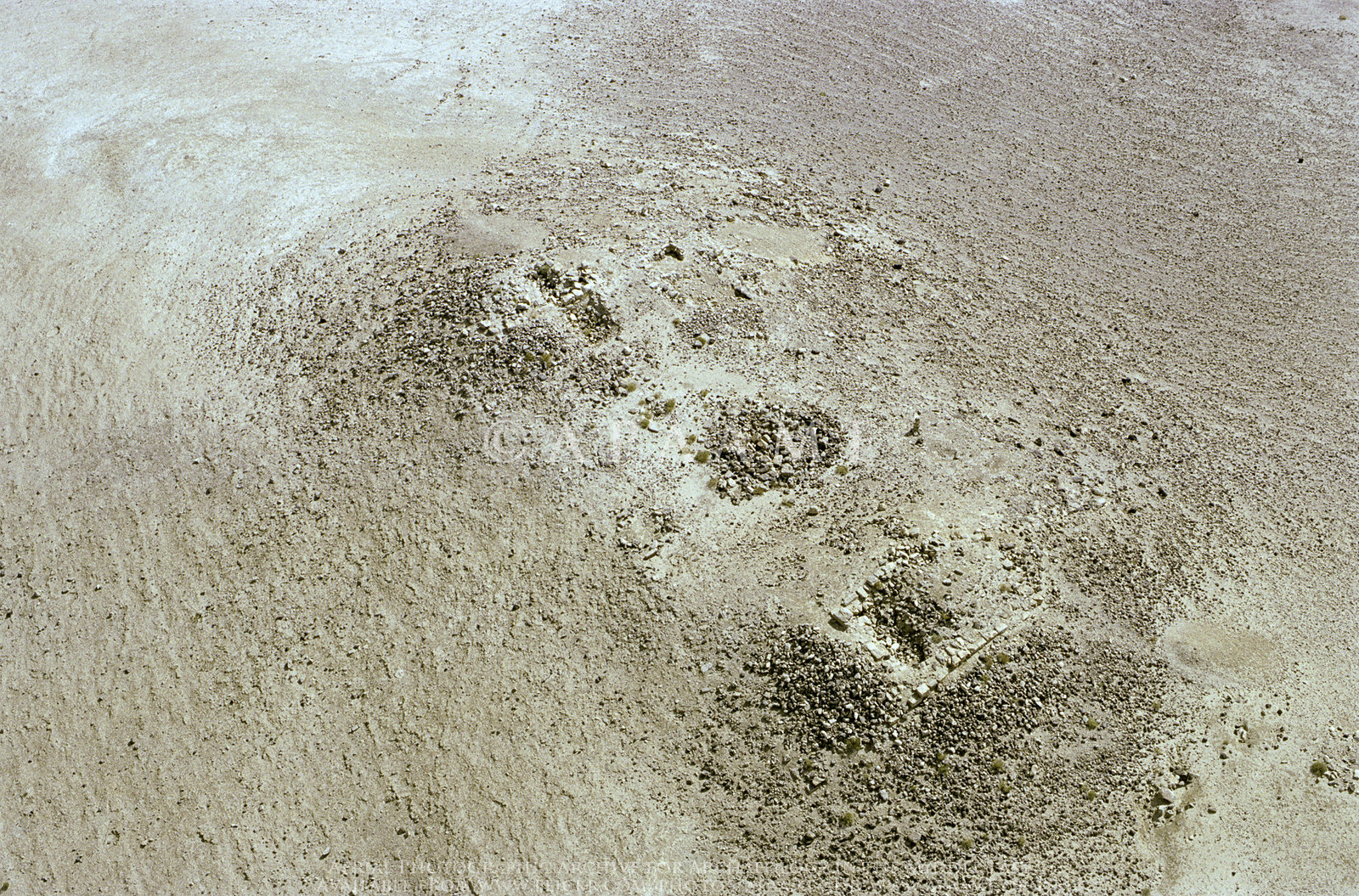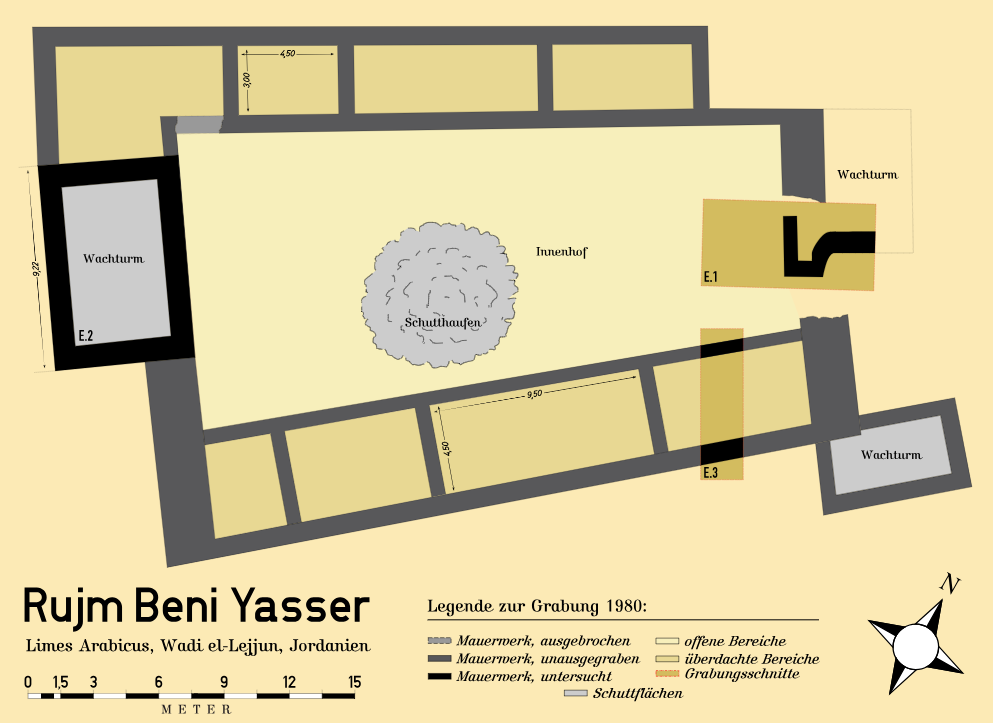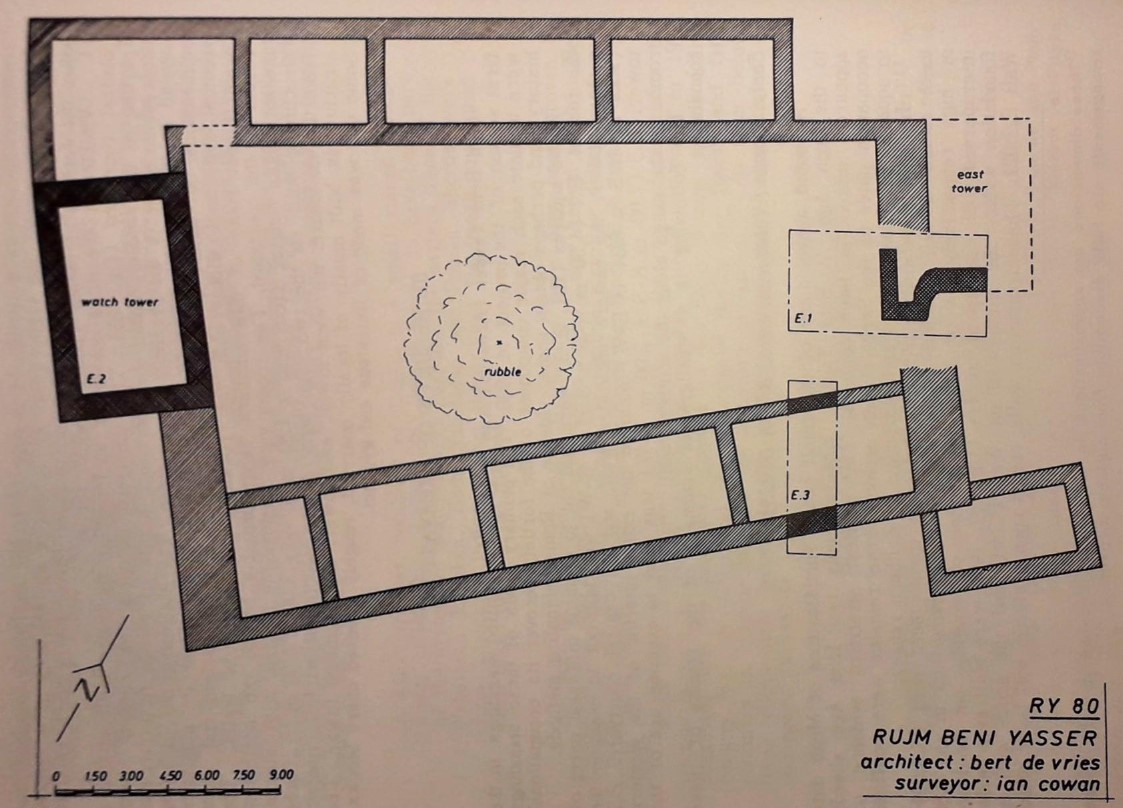Rujm Beni Yasser

APAAME
- Reference: APAAME_20081005_FFR-0782
- Photographer: Francesca Radcliffe
- Credit: Aerial Photographic Archive for Archaeology in the Middle East
- Copyright: Creative Commons Attribution-Noncommercial-No Derivative Works
Click photo for high res magnifiable image
| Transliterated Name | Language | Name |
|---|---|---|
| Rujm Beni Yasser | Arabic | روجم بيني ياسسير |
| Rujm Lejjun | Nelson Glueck's publications |
Introduction
Rujm Beni Yasser is about 1 km. east of el-Lejjun. The post was founded in the Early Roman period (first century B.C. or A.D.)
and was reoccupied during the fourth and fifth centuries in conjunction with the legionary occupation.
(
Bloom and Parker, 1987)
Maps, Aerial Views, and Plans
- Map of Limes Arabicus
Fortresses in Jordan from Wikipedia

 Limes arabicus, central part in Jordan - Azraq basin and Wadi el-Mujib basin. Red squares are
Roman fortresses and forts from the end of the 3rd/beginning of the 4th century.
Limes arabicus, central part in Jordan - Azraq basin and Wadi el-Mujib basin. Red squares are
Roman fortresses and forts from the end of the 3rd/beginning of the 4th century.
(modified from S. T. Parker, An Empire's New Holy Land: The Byzantine Perio, Near Eastern Archaeology , Sep., 1999, Vol. 62, No. 3 (Sep., 1999), p. 138)
Ursus - Wikipedia - CC-BY-SA 4.0 - Vicinity of Rujm Beni Yasser in Google Earth
- Plan of Rujm Beni Yasser
from wikipedia

 Fig. 85.1
Fig. 85.1
Plan of the Rujm Beni Yasser fortification according to the research of the Limes Arabicus Project
Mediatus - Wikipedia - CC BY-SA 3.0 & GFDL - Fig. 85.1 - Plan of Rujm Beni Yasser
from Bloom and Parker (1987)

 Fig. 85.1
Fig. 85.1
Plan of Rujm Beni Yasser with soundings
1980-89
Bloom and Parker (1987)
Stratigraphy
Bloom and Parker (1987)
| Stratum Period | Approximate Dates | Comments |
|---|---|---|
| Early Roman/Nabatean | ca. 63 BCE - 135 CE | Only two Iron Age sherds appeared, mixed in later contexts. The earliest stratified evidence of occupation dates to the Early Roman period. These remains were confined to squares E.1 (east tower) and E.3 (room in southern range). In the absence of both coins and a detailed ceramic chronology for Nabataean pottery in Moab, it is not yet possible to fix precise chronological parameters for this stratum. The pottery includes some painted Nabataean fine ware. Excavations at Petra suggest that this characteristic ware did not appear before the early first century B.C. If so, this provides a terminus post quem for the construction of the fortlet of Rujm Beni Yasser. |
| Post Early Roman Gap | 135-284 CE | There is no evidence for destruction from the uppermost Early Roman loci at Beni Yasser. Instead, the final occupation layer in the southern room (E.3:010) was covered by a layer of fine, windblown loess, suggesting a period of abandonment. This suggestion is further supported by the absence of any pottery from the mid-2nd to late 3rd centuries A.D. |
| Late Roman | 284-324 CE | Evidence of rebuilding - Evidence for this period was obtained from all three squares. |
| Early Byzantine | 324-502 CE | Evidence of continued occupation then assumed abandonment no later than ca. 500 CE. Tumbled stones found all over site but
whether they fell as a result of earthquakes or represent gradual collapse
could not be determined, especially in the total absence of numismatic evidence. |
| Later Occupation | The only evidence of later occupation is the presence of bedouin burials scattered over the site. ... Lacking the well-cut building stones characteristic of Lejjun and Fityan, Beni Yasser otherwise has remained largely undisturbed since its abandonment fifteen centuries ago. |
Dates from Ceramics Rujm el-Merih
- from wikipedia
| Location | Description | ||||||||||||||||||||||||
|---|---|---|---|---|---|---|---|---|---|---|---|---|---|---|---|---|---|---|---|---|---|---|---|---|---|
| Rujm el-Merih | The 11 × 9.5 meter rectangular watchtower [30] is located on an exposed hill with excellent visibility in all directions. [31] [32] The desert road that runs east of the Rujm el-Merih north to the legionary camp of Betthorus and south to the Qasr Abu Rukba watchtower appears to have been particularly important for surveillance. The Rujm el-Merih is founded on a circular platform, which can possibly be addressed as the foundation of an older structure. It has a 1.50 meter wide double-shell masonry, between which a stone fill was placed. [30] The structure was built less than two kilometers east of the Iron Age watchtower Khirbet Thamayil[33] built. The tower crew of Rujm el-Merih was able to see both the Khirbet el-Fityan fort, seven kilometers to the north, and the [31] 10.50 × 10.90 meter [34] Qasr Abu Rukba watchtower positioned around eight kilometers to the south. At Rujm el-Merih, Parker found numerous late Roman and early Byzantine shards. This temporal classification could also be confirmed by the architecture of the tower, because, like Qasr Abu Rukba, it appears to be a late Roman construction. [31] In addition to Parker's Limes Arabicus Project, the historian and biblical scholar James Maxwell Miller also investigatedwith his Archaeological Survey of the Kerak Plateau, which took place from 1978 to 1982, the Rujm el-Merih. His crew collected 168 ceramic shards, including 14 Nabataean, 4 late Roman and 2 early Byzantine. Despite otherwise similar results to Parker, Miller assigned the shell masonry of the tower to the Nabataeans and assumed that this site was reused in the Roman and early Byzantine periods. [35] Parker also assumed that a structure was originally founded at this location in the Nabataean period, but he stuck to his assumption that the remains of the tower that are visible today with its towers were considered an opus incertumThe walls listed must be viewed as new late Roman buildings. A list of the identified ceramic shards from Miller and Parker's field visits is then presented. Parker's team had collected a total of 59 shards, [36] which Parker dated as follows by 2006, at the conclusion of the Limes Arabicus project: [37]
|
Undated potential earthquake evidence
Plans
- Plan of Rujm Beni Yasser
from wikipedia

 Fig. 85.1
Fig. 85.1
Plan of the Rujm Beni Yasser fortification according to the research of the Limes Arabicus Project
Mediatus - Wikipedia - CC BY-SA 3.0 & GFDL - Fig. 85.1 - Plan of Rujm Beni Yasser
from Bloom and Parker (1987)

 Fig. 85.1
Fig. 85.1
Plan of Rujm Beni Yasser with soundings
1980-89
Bloom and Parker (1987)
Bloom and Parker (1987) found tumbled layers on the site but the tumble was undated and a seismic origin was neither confirmed or disaffirmed.
In the south room, above the ashy Late Roman occupation layer (E.3:005) was a similar layer, E.3:004. This layer was also rich in pottery (112 sherds) and bones (111, some charred). The latest pottery was Early Byzantine, of fourth century date. This locus was covered by a layer of rock tumble (E.3:003) that also yielded Early Byzantine pottery and marked the end of occupation in this room.
The circumstances surrounding the end of occupation of the fortlet remain shrouded in mystery. The post must have been abandoned no later than ca. 500, i.e. the end of the Early Byzantine period, because no pottery of later date appeared anywhere on the site, including all three squares and in surface sherding. The topsoil which covered the uppermost surviving Early Byzantine loci was full of tumbled stones. Indeed the surface of the site is covered with more stones than soil. These stones appeared to be the collapsed remains of the enclosure and towers. Whether they fell primarily as a result of one of the earthquakes that affected the valley in the fourth through sixth centuries or they represent a gradual collapse of the structure could not be determined, especially in the total absence of numismatic evidence.
References
Excavation Reports
Wikipedia pages
